- Details
- Hits: 8199
Article: The Railroad That Went No Place (but eventually made it) Part 1
by William C. Pletz, Ann Arbor Train and Trolley Watchers. Written in 1979.
Reprinted from the Inside Track
The History of the Detroit, Toledo & Ironton Railroad
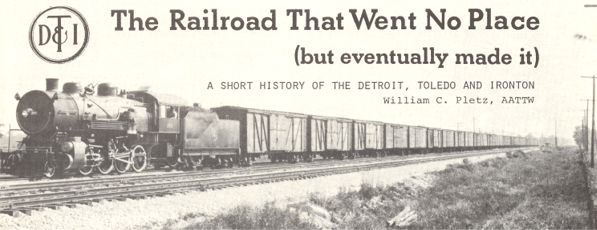
COMMENCING life as a local coal- and iron-hauling railroad whose promoters envisioned a lengthy narrow gauge line from southeastern Ohio's rich Jackson County mineral lands to Springfield, Ohio, Fort Wayne, Indiana and even on to Chicago, the Detroit, Toledo & Ironton's principal reason for existence today is traffic originating at the northern end of the route from the automobile factories in the Detroit area. The oldest portion of the present DT&I, however, is the southeastern most dozen or so miles north from Ironton, Ohio, on the Ohio River. But for all practical purposes, the DT&I dates back to the Springfield, Jackson & Pomeroy Railroad organized on December 17, 1874 in Ohio to link the three Ohio towns of its corporate name.
The Springfield, Jackson & Pomeroy was the offshoot of an earlier project, the Dayton & South Eastern, a narrow gauge railroad planned to run from Dayton to Jackson by a circuitous route that avoided some of the larger hills on a direct alignment. Refusing to accept a secondary role of having a branch line built to serve Springfield, the SJ&P was born when Springfield interests teamed up with disgruntled townspeople missed by the Dayton & South Eastern's route.
Both the SJ&P and the D&SE were constructed to provide an outlet for vast coal deposits and the iron furnaces of the Jackson and Wellston area in an era when the narrow gauge fever had struck with a vengeance. Construction of the SJ&P began in a northerly direction from Jackson on December 7, 1876, raising of the $800,000 in capital to start the line having taken two years. On March 26, 1877 work started at Springfield and for a brief time the SJ&P was operated in two unconnected segments. The last spike was driven July 18, 18/8 at Dills, 4/10-mile east of Bainbridge, and a 4-1/2-mile branch to Eureka, south of Jackson, was completed the following June. The SJ&P also built several coal mine spurs in the same area.
Hard times, however, soon hit the Springfield, Jackson & Pomeroy and on the 11th of October in 1879 the line was sold at a sheriff's sale in Springfield. The buyer was Oliver S. Kelly, who headed a group of ten, and on November 3 anew railroad company, the Springfield Southern Railroad Co., emerged. Kelly proposed, but never built, an extension from Jackson to the town of Rockwood in Lawrence County. He did, however, convert the line to standard gauge, utilizing most of the narrow gauge bridges and much of its 35-lb. rail, as well as most of the narrow gauge ties; every original eighth tie was replaced with a tie of conventional standard gauge until finances permitted total replacement. On May 23, 1881, the short-lived Spring Southern became the Ohio Southern Railroad Company and a period of relative prosperity set in. The Ohio Southern was leased by the Indiana, Bloomington & Western Railroad to be a connecting link between that company, then building east from Indianapolis to Springfield, and the Chesapeake & Ohio building westward. Although the IB&W (later to become the Peoria & Eastern) reached Springfield, the proposed connection with the C&O at Huntington, West Virginia, never materialized, and IB&W control of the Ohio Southern ceased in April of 1892.
From November 28, 1883, until May 31, 1884, the Ohio Southern operated a small railroad, the Cincinnati, Columbus & Hocking Valley -a line whose name was nearly as long as its trackage. The CC&HV extended from a connection at Jeffersonville with the Ohio Southern west to Claysville Junction on the Little Miami Railroad's Cincinnati-Xenia main line. Organized on December 9, 1875 as the Waynesville, Port William & Jeffersonville Railroad Co., also a narrow gauge line, its organizers were among those involved with the Springfield, Jackson & Pomeroy. The CC&HV completed 15 miles from Jeffersonville to Port William by October of 1877, and the following month was reorganized as the Columbus, Washington & Cincinnati Railroad Co. It is obvious from its name that the proposed termini were to be Columbus and Cincinnati and, with these cities in mind, the company built to the Little Miami connection at Claysville Junction, now named Roxanna. But profitability eluded the ~W&C and the line was abandoned and removed in 1887, although a portion of the roadbed was purchased by the Ohio Southern in March of 1884 as part of its scheme to construct a Cincinnati-Columbus line at right angles to its own road. Built from Sedalia through Jeffersonville and on to Kingman, funds were exhausted before either end of the line was finished, and the entire railroad was abandoned later in several stages between 1931 and 1941.
But this is getting ahead of the story...
In order to obtain new connections and a longer road haul on freight originating on -- its line, the Ohio Southern in December 1892 commenced building an extension in a northerly direction from Springfield to Lima. Completed on December 28, 1893, this was followed in the spring of 1894 by the extension of a spur line to Wellston. Later that year, three coal mine spurs were authorized, including one to Cornelia. But financial resources were too strained by the Lima extension project and the Ohio Southern was forced into receivership on May 9, 1895 at a time when construction of the Cincinnati-Columbus line ground to a halt short of the Pennsylvania connection at Waynesville or a connection at Columbus with the Cleveland, Akron & Columbus. A group of bondholders purchased the property on October 15, 1898 at a foreclosure sales, and the Ohio Southern was history.
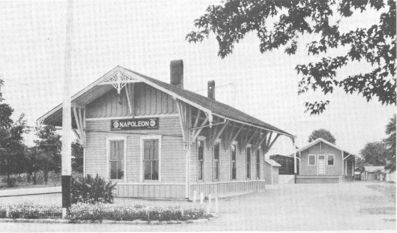
JUST PRIOR to the receivership of the Ohio Southern, anew company -the Lima Northern Railway Company -was organized in Ohio on March 27, 1895. The Lima Northern, as its name implies, built north from Lima to reach a Wabash connection at Lima Junction, a point near Seneca, Michigan, and from there reached Adrian over the Wabash, an arrangement that lasted until fairly recent time when the present DT&I abandoned the line south from Adrian into Ohio. On March 27, 1896, the Detroit & Cincinnati Railway Co. was incorporated in Michigan to build between the state line in Lenawee County, Michigan, and the city of Detroit. However, the only trackage laid down, in 1895 and the following year, was from the Ohio-Michigan line north to the Wabash connection near Seneca by the Lima Northern; the Detroit & Cincinnati is not known to have constructed any trackage. On February. 20, 1897, the D&C was reincorporated in Michigan as the Detro1t & Lima Northern Railway Company. The following April 10th an amendment increasing the capital stock and changing the D&LN's termini to Detroit and a point three miles east of Morenci, Michigan, was filed in Michigan. A further amendment authorized extension of the D&LN to Lima so as to include the line of the Lima Northern Railway acquired on May 10, 1897.
THE HISTORY of the railroads of southeastern Michigan is, to say the least, involved and very difficult to unravel. To continue, then, with this history we have to backtrack a number of years to the early 1870's when the Chicago & Canada Southern Railroad was attempting construction of a direct line from Buffalo through southern Ontario, across the lower part of the Detroit River via car ferry and bridges to a point near Trenton, Michigan, and thence westward to Chicago. In late October of 1870 organizational papers were filed in the province and states through which the line was to pass. Building west from Trenton, working capital was gone when the rails reached the small northern Ohio community of Fayette, just over the Ohio-Michigan state line southwest of Morenci, and the C&CS became another victim of the Panic of 1873. The C&CS was sold on November 23, 1888 to the Detroit & Chicago Railroad.
The Detroit & Lima Northern pushed construction from Adrian into Tecumseh and the first train ran over this 14-mile extension on May 27, 1897, using the depot of the Cincinnati, Jackson & Mackinaw railroad at Tecumseh. Three months later the D&LN acquired the Michigan Division of the CJ&M which had meanwhile been reorganized as the Detroit, Toledo & Milwaukee Railroad. This route extended from Toledo by means of trackage rights over The Detroit, Toledo & Ironton in 1906. The Ann Arbor Railroad, then over lots own rails to Tecumseh, Jackson, and Allegan, continuing by trackage rights to Holland and Grand Haven on the Lake Michigan shore.
On August 21, 1897, the Ferguson Construction Company started work on an extension of the D&LN from near Dundee to Detroit. By running over the recently-acquired Detroit, Toledo & Milwaukee between Tecumseh and Dundee, the Detroit & Lima Northern now would be able to enter Detroit. A portion of the former Chicago & Canada Southern from Chandler's Curve (also called, simply, Chandler's) , located one mile south of Trenton, to Dundee was purchased from the Lake Shore & Michigan Southern by the D&LN in March of 1898. On April 15 of that year the D&LN suspended operations and on June 1 the Lake Shore & Michigan Southern acquired the Detroit, Toledo & Milwaukee. The D&LN line to Detroit was completed in May, and trackage rights were obtained to run D&LN trains over the Dundee-Tecumseh segment on the LS&MS. About the same time, 4.75 miles between Dundee and a place called Durban were abandoned, this actually being a portion of a predecessor company, the South Eastern Michigan Railway Co. that had been merged with the Chicago & Canada Southern on July II, 1871. Most, if not all, of the remaining Detroit & Chicago trackage was acquired by the LS&MS. On July 15, 1898, the general offices of the Detroit & Lima Northern were established in its northern terminal in Detroit.
WE NOW HAVE TO REFOCUS our attention back to Ohio where the Detroit & Lima Northern had become involved in planning a line from Columbus to Fort Wayne, Indiana, the Columbus Northwestern Railway, incorporated on August g, 1897. The CNW constructed a small portion of its line in Ohio from Columbus Junction (later named Salter's) to Peoria, a distance of 40.7 miles, completed in August 1898 by the Detroit & Lima Northern, and finishing an additional 17 miles from Columbus Junction to St. Mary's by November 1st. Then, 14.6 miles were leased from the Ohio Southern from Lima to Columbus Junction to provide a physical link with the D&LN. However, the buyers of the Ohio Southern refused to renew this lease and on December I, 1900 the D&LN divested itself of any further financial affiliation with the Columbus Northwestern and ended DL&N service into Columbus over the Toledo & Ohio Central. The Columbus Northwestern later was to become a portion of the TOC system. Most of the St. Mary's branch, as it came to be called, has been abandoned.

On September 6, 1898, a receiver was appointed for the Detroit & Lima Northern, followed six days later by a second receiver who operated the company until May 23, 1901, when New York banker Frederick J. Lisman purchased the line and changed its name to the Detroit Southern Railroad Company. Lisman was an authority on railroad finances and was prominent in that field for many years, with railway and financial publications publishing his articles during his years of prominence. Lisman bought trackage from Delray, Michigan {then a separate municipality, later absorbed into the city of Detroit) south and west to Dundee, 39.4 miles, and from Tecumseh to Lima, and a short branch at Lima, a total of 138 miles of railroad.
FROM JUNE I, 1901, THE OHIO SOUTHERN RAILROAD COMPANY ceased to exist, having been taken over by the Detroit Southern which at the same time acquired the Detroit & Lima Northern. The two companies, the OS and the D&LN, operated separately from May 25, 1901 until merged on June 30, 1901 under a single management headed by Lisman's Detroit Southern Railroad.
It was the Ohio Southern that opened the line through to the Ohio River. In the opening part of this account mention was made of the extreme southern end of the line at Ironton, Ohio, and now it's time to examine this segment of the railroad. On February II, 1848, a Special Act of the Ohio General Assembly authorized the incorporation of the Iron Railroad Company, and during 1849-50 a six-mile line was built from Ironton to the Vesuvius Tunnel Mines, extended in 1853 to Center Station. Typical of the era's primitive construction methods, cross ties were placed every six feet supporting timber stringers to which were spiked strap rails said to be obtained from the Little Miami Railroad. Timber bridges were supported by stone abutments. By 1858, though, the structure spanning Sterrns Creek north of Ironton was considered too weak to carry increased loads and a wrought iron bow-string truss, patented by W. H. Moseley and fabricated in Cincinnati, was erected over the stream. This wrought-iron bridge remained in service until 1924, when it was removed and placed on exhibition in the Henry Ford Museum in Dearborn, Michigan, some years later.
That far-flung midwestern narrow-gauge system, the Toledo, Delphos & Burlington Railroad Company, having already acquired the Dayton & South Eastern, added the Iron Railroad on October 25, 1881. A set of narrow gauge rails was laid from Bartles to Ironton between the 4-ft., 10-in. gauge of the Iron RR. The Toledo, Cincinnati & St. Louis, successor to the Toledo, Delphos & Burlington, went bankrupt and was sold on June 28, 1884. From this brief encounter emerged the Iron Rail Company, organized on July 23, 1884. As noted, the Iron Railroad has been built to a gauge slightly wider than the standard 4-ft., 8-1/2-in. gauge, so in a single day, April 6, 1887, the Iron Railway was converted to standard gauge. Interestingly enough, the only tunnel on the present Detroit, Toledo & Ironton, is located near the north end of this original segment of the Iron Railroad.
Various spurs to serve quarries, coal mines and iron furnaces were built during the 1870s and 1880s to give the Iron a total length of 18.35 miles. For another 18 years, until September 25, 1902 when it was acquired by the Detroit Southern, the Iron Railroad continued its independent existence. Construction of an 18.6 mile extension north from Lisman to a connection with the Baltimore & Ohio Southwestern's Portsmouth to Hamden branch at Bloom Junction has started the previous May by the Detroit Southern. Trackage rights over the B&OSW into Jackson were gained and are in effect today. Service into Ironton began June 13, 1903.
Meanwhile, back to the Detroit Southern. Several lesser companies operating minor segments of track were either acquired or organized, and have not be included in this account in the interest of brevity. Suffice to say that during the brief tenure of the Detroit Southern a general upgrading of the property was undertaken, including a number of new facilities as well as purchases of motive power and rolling stock. But bad time stuck once again, and on July 16, 1904, the Detroit Southern was forced into receivership. Following a sale the following May, there emerged the Detroit, Toledo & Ironton Railway Company, a name that has survived in one for or another for nearly three-quarters of a century.
ON May 1, 1905, following the traditional sale, there emerged from a series of bankruptcies, foreclosures and reorganizations going back many years a new railroad company -- the Detroit, Toledo & Ironton Railway Company, a name that has, in one form or another, survived to the present. Incorporation of the new line took place in Michigan the following day. The new company laid down no additional trackage but continued the program of upgrading the property started by the Detroit southern; new 85-pound rail was placed and the shops at Jackson, Ohio, were built. The company then owned or operated nearly 400 miles of main line and branches, 65.68 miles in Michigan and 331.22 miles in Ohio.
From June 1, 1905 until November 25, 1910 the DT&I and the Ann Arbor Railroad were operated under a single management through the purchase of 72% of Ann Arbor stock by the DT&I. But as the result of the DT&I slipping into receivership on February 8, 1908, the stock in the Ann Arbor was sold at auction on November 25, 1910, and the Ann Arbor resumed life as an independent road. Control of the Ann Arbor, however, had given the DT&I a Toledo entrance as well as a longer line haul for its traffic.
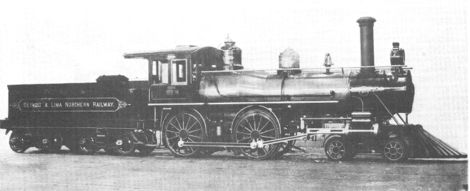
Sale of the Northern Division of the DT&I Railway - Delray, Michigan to Lima, Ohio - and the Southern Division from Bloom Junction to Ironton, Ohio, was held on June 28, 1913. The Ohio Southern (or Middle) Division, the line from Lima to Rockwood in Lawrence County in Ohio, was sold on April 27, 1913, but the following March 2nd the above properties were gathered back into the fold of the DT&I, the Detroit, Toledo & Ironton Railroad having been organized in Delaware on February 21, 1914. Under the new corporate title many improvements were started that included heavier rail, rebuilding of all trestles in Michigan and several in Ohio, new ballast and fences, and general renovation of many buildings. Although no new construction was begun by the "new" DT&I, the road did acquire the 22.28 Toledo, Ann Arbor & Jackson interurban electric line that grew out of several schemes to connect Jackson and Ann arbor with Toledo and Detroit. Only that portion of the Toledo-Detroit from West Toledo to a junction with the DT&I at Dundee was retained, although additional grading toward Ann Arbor had been completed. The bridge supports of the line remain to this day, and can be seen on the east side of Platt Road south from Willis Road. The introduction of the self-propelled McKeen motor cars on the paralleling Ann Arbor Railroad defeated the plans of the TAA&J to enter Ann Arbor.
Federal operation of all railroads following the nation's entry into the first World War lasted from the first of January, 1918 until March 20, 1920. In common with nearly all railroads maintenance was kept to a minimum and the DT&I, like the others, emerged from this period much the worse for the wear and tear of wartime traffic. A wholly-owned subsidiary, the Detroit & Ironton Railroad Company was incorporated on June 29, 1920 for the purpose of building a line from Flat Rock to Springwells (later Fordson and now Dearborn), Michigan, to handle the traffic from the Ford Motor Company's growing plant on the River Rouge.
Probably the best known era of the Detroit, Toledo & Ironton began on July 10, 1920, when the Ford Motor Company purchased the company for about $5 million. The DT&I was truly the "Darned, Tired and Irksome" as two and a quarter years of wartime neglect had undone much of what had been accomplished before governmental control. For his part, Ford received over 300 miles of rundown main track and branch lines, 80 locomotives, 2,800 freight and a couple dozen passenger cars - most of this in anything but satisfactory condition. Henry Ford himself assumed the president's chair in March, 1921, and made frequent trips over the road, often in the locomotive cab.
The Ford years, of course, are a book in themselves. Ford literally poured capital into the line for a thorough modernization and upgrading to his personal high standards, a level that even today would be hard to equal. The Ford acquisition marked the beginning of an era that was in complete contrast to the DT&I's first fifty years that saw operation of the railroad by a half dozen different companies and receivership four times. Although direct Ford control ended in 1929, a close relationship between the railroad and the auto manufacturer still exists that sees a great percent of rail traffic in and out of the sprawling Rouge plant moving via the DT&I.
A few highlights of the Ford years are in order as southeastern Michigan figured chiefly in the scheme of things. The temptation is great to mention Henry Ford's revolutionary ideas for running the railroad - ideas that met with less than endorsement from contemporary railroad officials on other lines. But these ideas have been documented numerous times, although a thorough and accurate study of Ford's ownership has yet to be printed.
To improve access to the Rouge factory, on August 8, 1922, the Ford company began building the Dearborn branch but this work was later turned over to a private contractor who finished the 13.6 double-track line from the Rouge to D&I Junction (north of Van Born Road west of Allen Road) by October 1, 1923. Additional construction followed late in 1924 when the 55.71 mile Durban-Malinta cut-off, built under the name of the Detroit & Ironton, was started. This work also included a new classification yard at Flat Rock. The cut-off which chose a direct route from a point east and slightly north of Dundee to Malinta, Ohio, replaced the circuitous route through Tecumseh, Adrian and Wauseon, with a nearly straight track (there is one curve) and includes an 8-mile long grade elevation to life DT&I trains over the former NYC Railroad and Wabash lines west of Delta, Ohio.
Electrification of the railroad from the Rouge to Carleton was programmed but only a portion of this was actually operated by traction. (Ford did hold the grand idea, however, of extending the electric line all the way to Ironton on the Ohio River - and even beyond into Kentucky and eventually to link up with the electrified Virginian Railway.) On June 1, 1925, trial runs were made with two articulated, motor-generator electric locomotives. Numbered 500 and 501 with a D-D+D-D wheel arrangement, the articulated pair was designed by Ford engineers with Westinghouse electrical components. Weighing 785,600 pounds, the units had a starting tractive force of 250,000 pounds, 2,200 vole AC current being converted to 600 volts DC for the traction motors. Power for the line came from the Ford Highland Park plant and later some was generated at the Rouge works. Top speed of the dark green and red giants was 43 m.p.h., and after several months of tests, they entered service between the Flat Rock Yard and the Rouge Plant early in 1926.
There seems little doubt that Ford envisioned considerable use of electric motive power and certainly pioneered the motor-generator concept that was adopted in later times, but disenchantment and frustrations caused him to abandon further electrification beyond the first 17 miles under the concrete arches.
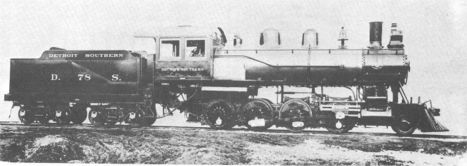
During the decade of the 1920's Ford's other notable achievement, other than that of labor relations that brought DT&I wages generally higher than that of the industry, also saw the rebuilding of most, if not all, of the road's locomotives. The use of weight-savings materials, highly polished boiler jackets, metal cabs, lighted footboards, and raised metal numbers and the company insignia replaced painted letters and numbers. Cleanliness was required of all employees and heaven help anyone caught not exerting every effort in that direction!
Added to the roster were two Pullman-built gas-electric cars, numbers 35 and 36, designed in cooperation with Ford engineers. The cars made extensive use of aluminum in their construction, and they replaced steam power on passenger trains No. 1 and 2 between Delray and Bainbridge beginning October 25, 1926. Operated with three-man crews, schedules were cut from 11 hours to 9 1/2 hours each was for the 28-mile trip. The cars later had their engines removed and were used as combine cars behind steam locomotives.
Ford's control of the DT&I ended June 27, 1929 when his company sold the railroad to Pennroad Corporation, a subsidiary of the Pennsylvania Railroad, for approximately $36 million, thus realizing a neat profit for the Ford company of $31 million. During Ford control, the line was transformed from a streak of rust into an extremely efficient and profitable operation, the likes of which has or will seldom be seen in this country. By the end of 1929 permission to abandon the 17-mile Wellston branch was given by the ICC, brought about by the closing of many coal mines. Earlier the following year the two-mile branch built by the Iron Railroad form Bartles to Dean had its tracks removed. 1930 also saw the demise of Ford's electrification plan when in March the big two-unit electric locomotive was scrapped and overhead wire taken down. Many of the concrete arch supports for the wires were removed in 1947 to form rip--rap for the embankment at Mosquito Lake in southern Ohio. Hover, many of the arches are still in place between the Rouge area to well beyond Flat Rock, a tribute of sorts to a man whose vision was far ahead of his time.
In May 1930 the 4.9 mile portion of the old main line from Durban to the NYC connection in that village was removed. The Depression was beginning to make itself felt and further retrenchment continued on the railroad. Permission was asked in November, 1931, to end all passenger service. On December 23 of that year the Toledo-Detroit Railroad was merged with the DT&I, having been a wholly-owned subsidiary since its acquisition some 15 years previously.
JOINT CONTROL of the Detroit, Toledo & Ironton was approved May 3, 1920 by the ICC and Pennroad sold 245,329 shares of DT&I stock to the Pennsylvania Company, a PRR investment subsidiary, and to the Wabash Railway, then itself under the control of the Pennsy. The sale actually took place on February 28, 1931.
Although several diesel switchers had been purchased beginning soon after World War II, it wasn't until August 22, 1951 that the first regular diesel-powered road runs on the Northern Division began with EMD units 950 and 951 on train DC-8 from Springfield to Flat Rock, the same two units making the return run on DJ-1 the next day. Additional diesels having the same two units making the return run on DJ-1 the next day. Additional diesels having been delivered, units 952, 953, and 954 worked south from Springfield to Jackson on December 27th. Some steam power held on for a few years more and it wasn't until Christmas Eve of 1954 that a Leipsic turn arrived at Flat Rock and steam operation on the DT&I was at an end. The advent of super-power locomotives in the late 1930's brought some of the handsomest 2-8-4s and, later, the 2-8-2s ever seen in this part of the nation. All passenger service on the DT&I finally ended on May 8, 1954 when a mixed train from Springfield to made its last run.
March 3, 1958 saw abandonment of that portion of the Tecumseh Branch as it became following the completion of the Malinta cutoff, from Lear (originally Detroit Junction of the Detroit & Lima Northern days) to Page in favor of trackage rights over the Wabash, a distance of about nine miles. Truly a case of history repeating itself.
Sale of the Wabash-controlled Ann Arbor Railroad was announced on February 27, 1961, pending approval by the ICC, making the second time that the "Annie" came under the control of the DT&I. Approval was eventually granted and the sale became effective August 29, 1963. Trackage rights were obtained fro the DT&I over the Ann Arbor from Diann (south of Dundee) into Toledo, a route of 19.8 miles, and that portion of the DT&I's Toledo Branch, the former Toledo-Detroit Railroad line between Petersburg Junction and Lambertville, was abandoned and removed effective December 23, 1965.
In 1966 work commenced on an estimated $4.5 million, three-year yard improvement project at Flat Rock that included a 36-track classification yard with semi-automatic retarders. Operation over parallel Baltimore & Ohio trackage between Leipsic and South Cairo, Ohio, 20 3/4 miles north of Lima, began on February 14, 1966, and the DT&I also abandoned 17.33 miles of former Detroit & Lima Northern trackage in Michigan. OnOctober 15, 1973 the Ann Arbor Railroad entered into reorganization proceedings under Section 77 of the Federal Bankruptcy Act as the result of action by the Pennsylvania Company, the principal stockholders of the DT&I, to whom the Ann Arbor owned a considerable amount of money from previous advances. Thus, while the Ann Arbor was under the charge of a court-appointed trustee, the DT&I continued operating the Ann Arbor as a contractor.
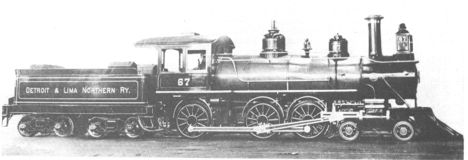
That the Ann Arbor was a financial drain on the DT&I is undisputed. However, the Pennsylvania Company, wanting to dispose of its railroad holdings, did not consider the Ann Arbor an asset to the DT&I's prospects. Among the more important reasons for making continued operation of the Ann Arbor undesirable for its owners were (10 the high cost of the Lake Michigan car ferry operation, (2) a serious drain of traffic away from cross-lake routes by almost all other railroads, (3) increased car lengths, making the car ferries even more costly, (4) the Ann Arbor's unfavorable rate diversion structure, and (5) a lack of on-line traffic originating on the Ann Arbor.
EARLY IN 1975, as the result of proposals to restructure railroads in the Northeast to, in theory make them profitable, it was proposed along with many similar proposals that all DT&I trackage south of Lima be abandoned, and traffic diverted to other railroads whose plants were not being utilized to their capacity. This radical proposal was allowed to die in the light of more enlightened studies and no one is known to mourn its death.
With the birth of Conrail and the recognized need for a health Northeastern rail system outside of the new giant, many companies found themselves suddenly expanded into relatively new, if not completely new, service territories. Such was the case of the DT&I, for although it had established a through service with the Pennsylvania back in the 1950's that saw the black and orange units of the DT&I running into Cincinnati, almost overnight it had trackage rights over Conrail from Springfield to South Charleston, Ohio, into Cincinnati. A first, two daily trains were scheduled, one to the Southern and one to the L&N. Today, unit coal trains are operating in conjunction with the L&N that sees DT&I diesels in the heart of Kentucky.
Mid-1977 saw the independence of the DT&I threatened by a proposal by Norfolk & Western and the Chessie System to acquire the railroad. The initial offer of $23,625,000 was immediately countered by the Grand Trunk Western, who also asked to purchase N&W's half interest in the Detroit & Toledo Shore Line. On December 3, 1979 the ICC gave approval to GTW to buy the DT&I, confirming a court decision of July 23 favoring the purchase. The ICC took the stand that the GTW proposal represented an End-to-end merger that would retain the competitive status of the Detroit-Cincinnati corridor. The ICC order allowed the Grand Trunk Western six months to make final a sales agreement with the Pennsylvania Company, the majority stockholder of the DT&I.
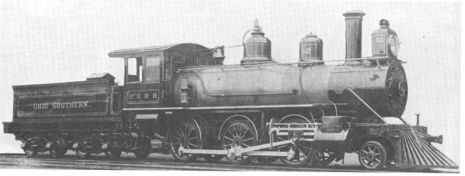
Meanwhile, deteriorating trackage and insufficient business to warrant costly repairs brought about abandonment in May 1978 of the Wauseon-Tecumseh portion of the old D&LN main line. N&W assumed operation of the Adrian-Tecumseh segment to serve a Fisher Body plant on the line, but south of Adrian the rails were lifted, although the industrial district at Wauseon generates sufficient business to warrant operating to that town from Malinta through Napoleon.
IN EARLY 1980 the Detroit, Toledo & Ironton continues hauling a substantial amount of automobile traffic in and out of the Detroit area as well as having a reasonably diversified general freight traffic. business is sufficiently good as to require occasional leasing of motive power from other railroads to handle the business. The 100-car unit coal trains are certainly a far cry from the diminutive 25-car Springfield, Jackson & Pomeroy narrow gauge trains that brought black diamonds from the rich mineral region around Jackson to a fuel-hungry Springfield, Ohio, just over a century ago.
Photo info: First, a DT&I freight train. 2nd photo, the DT&I depot and freight house at Napoleon, Ohio. These were typical of the D&LN design fromt he late 1800's. This photo was made in July, 1927. Detroit was 103.6 miles away and Ironton 275.1 miles south. As of 1979, these buildings were still used by the railroad. 3rd photo, a map of the DT&I. 4th photo, the Detroit & Lima Northern No. 7. which was chiefly used for passenger service. 5th photo, Detroit Southern No. 78. 6th photo, Detroit & Lima Northern No. 67. 7th photo, Ohio Southern No. 32. [All, the author's collection].
IN APPRECIATION:
THE INSIDE TRACK is sincerely indebted to several persons whose contributions added much to this article. For their research, knowledge and copy reading, thanks to C. L. Towle, Thomas VanDegrift, Thomas Dworman, F. W. Colburn, Ken Borg and Oliver Bathurst. For the use of their photos, gratitude is due Thomas VanDegrift, John Bjorklund, Joe Lieblang of the DT&I, Fred C. Olds, and especially Kenneth Schramm for making available from his collection of photos from the Ford Archives of the Napoleon depot, a DT&I freight train and the electric locomotives.
All photos on this page from the author's collection.
Editor's Note: The DT&I became part of the Grand Trunk Western, and later the CN. Much of it was spun off by the CN to the Indiana & Ohio railroad.
Bibliography
The following sources are utilized in this website. [SOURCE-YEAR-MMDD-PG]:
- [AAB| = All Aboard!, by Willis Dunbar, Eerdmans Publishing, Grand Rapids ©1969.
- [AAN] = Alpena Argus newspaper.
- [AARQJ] = American Association of Railroads Quiz Jr. pamphlet. © 1956
- [AATHA] = Ann Arbor Railroad Technical and Historical Association newsletter "The Double A"
- [AB] = Information provided at Michigan History Conference from Andrew Bailey, Port Huron, MI

